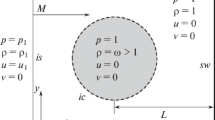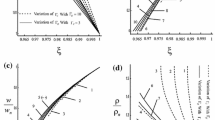Abstract
The solution of the gasdynamic equation with allowance for the heat transfer in the relaxation of the heat flux is analyzed. The relations expressing the laws of conservation on the front of strong discontinuity of the quantities sought, including the discontinuity of the temperature and the heat-flux density, are discussed. The possibility of existence of two shock waves with fixed initial data is shown using the self-similar solution of the problem on gas motion ahead of the piston. The occurrence of two strong discontinuities is due to the presence of different velocities of propagation of gasdynamic and thermal disturbances — the velocity of sound and the finite rate of heat transfer at a nonzero time of relaxation of the heat flux.
Similar content being viewed by others
References
P. P. Volosevich, V. P. Kosarev, and E. I. Levanov, Allowance for the Constraint of the Heat Flux in Numerical Experiment [in Russian], Preprint No. 21 of the M. V. Keldysh Institute of Applied Mechanics of the USSR Academy of Sciences, Moscow (1978).
V. P. Kosarev, E. I. Levanov, and E. N. Sotskii, A Method for Description of the Process of Electron Heat Conduction in a High-Temperature Plasma [in Russian], Preprint No. 142 of the M. V. Keldysh Institute of Applied Mechanics of the USSR Academy of Sciences, Moscow (1981).
E. I. Levanov and E. N. Sotskii, Heat transfer with account for the heat-flux relaxation, in: Mathematical Simulation. Nonlinear Differential Equations [in Russian], Nauka, Moscow (1987), pp. 155–190.
P. P. Volosevich, E. I. Levanov, and E. V. Severina, Mathematical simulation of heat transfer in a moving medium with account for the heat flux relaxation and volumetric sources of enegry, Izv. Vyssh. Uchebn. Zaved., Matematika, No. 1(512), 31–39 (2005).
A. V. Luikov, Heat and Mass Transfer: Handbook [in Russian], Énergiya, Moscow (1978).
O. N. Shablovskii, Relaxation Process in Nonlinear Media [in Russian], GGTU im. P. O. Sukhogo, Gomel’ (2003).
E. M. Burkhanov, E. N. Lyutikov, and S. A. Medin, Hyperbolic Thermal Conductivity and the Second Law of Thermodynamics [in Russian], Preprint No. 2-462 of the Joint Institute of High Temperatures of the Russian Academy of Sciences, Moscow (2002).
A. N. Tikhonov and A. A. Samarskii, Equations of Mathematical Physics [in Russian], Izd. MGU, Moscow (1999).
O. N. Shablovskii, Propagation of a planar shock thermal wave in a nonlinear medium, Inzh.-Fiz. Zh., 49, No. 3, 436–443 (1985).
P. P. Volosevich, S. P. Kurdyumov, L. N. Busurina, and V. P. Krus, Solution of a one-dimensional plane problem on piston motion in an ideal heat-conducting gas, Zh. Vych. Mat. Mat Fiz., 3, No. 1, 159–169 (1963).
P. P. Volosevich and E. I. Levanov, Self-Similar Solutions of the Problems of Gas Dynamics and Heat Transfer [in Russian], Izd. MFTI, Moscow (1997).
P. P. Volosevich, E. I. Levanov, and S. A. Fetisov, Self-Similar Solutions of the Problems of Heating and Plasma Dynamics [in Russian], Izd. MFTI, Moscow (2001).
Author information
Authors and Affiliations
Additional information
__________
Translated from Inzhenerno-Fizicheskii Zhurnal, Vol. 79, No. 4, pp. 57–68, July–August, 2006.
Rights and permissions
About this article
Cite this article
Volosevich, P.P., Levanov, E.I. & Severina, E.V. Temperature shock waves in a moving medium with allowance for the relaxation of the heat flux. J Eng Phys Thermophys 79, 685–698 (2006). https://doi.org/10.1007/s10891-006-0154-6
Received:
Issue Date:
DOI: https://doi.org/10.1007/s10891-006-0154-6




